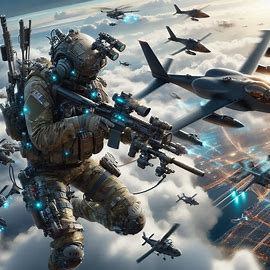
Introduction
Military aircraft have become indispensable in modern warfare, dramatically transforming how conflicts are fought and won. Their speed, flexibility, and advanced technology provide forces with unparalleled advantages in surveillance, strike capability, troop movement, and air dominance. Understanding the role of military aircraft in modern warfare highlights their strategic importance and the evolving nature of combat.
This article offers an in-depth analysis of the various types of military aircraft, their operational roles, technological innovations, and tactical impact on contemporary battlefields. We also explore challenges and future trends shaping the integration of military aviation into global defense strategies.
1. Types of Military Aircraft and Their Roles
1.1 Fighter Aircraft: Air Superiority and Beyond
Fighter aircraft are designed primarily to achieve air superiority, engaging enemy aircraft to control the skies. They are fast, agile, and equipped with advanced radar and weaponry to:
-
Intercept hostile aircraft
-
Escort bombers and transport planes
-
Provide close air support for ground forces
Modern fighters, like the F-35 Lightning II and Su-57, also perform ground-attack missions, making them versatile in both offensive and defensive roles.
1.2 Bombers and Attack Aircraft: Strategic and Tactical Strikes
Bombers deliver powerful strikes against enemy infrastructure, supply lines, and strategic targets. They can carry large payloads of bombs, missiles, and precision-guided munitions. Attack aircraft, such as the A-10 Thunderbolt II, focus on close air support and battlefield interdiction, attacking tanks, artillery, and troop formations.
Both types contribute to weakening enemy capabilities and shaping the battlefield.
1.3 Reconnaissance and Surveillance Aircraft
Intelligence is critical in warfare, and reconnaissance aircraft provide real-time battlefield data through advanced sensors, radar, and imaging technology. Examples include the RQ-4 Global Hawk and U-2 spy planes. These aircraft enable:
-
Monitoring enemy movements
-
Assessing damage post-strike
-
Providing targeting data for precision attacks
1.4 Transport and Tanker Aircraft
Transport aircraft like the C-130 Hercules move troops, equipment, and supplies rapidly across theaters. Aerial refueling tankers extend the operational range of fighters and bombers, enhancing mission endurance and flexibility.
2. Technological Advancements Enhancing Military Aircraft Capabilities
2.1 Stealth Technology
Stealth design minimizes radar and infrared signatures, allowing aircraft to penetrate heavily defended airspace. The B-2 Spirit and F-22 Raptor exemplify how stealth enables surprise attacks and reconnaissance without detection.
2.2 Precision-Guided Munitions
Modern military aircraft use GPS-guided bombs and missiles to strike targets accurately, reducing collateral damage and increasing mission effectiveness.
2.3 Network-Centric Warfare and Sensor Fusion
Integration of sensors and communication systems enables aircraft to share battlefield data in real-time. This connectivity enhances situational awareness, target acquisition, and coordinated strikes.
3. Tactical Roles of Military Aircraft in Combat Operations
3.1 Air Superiority and Control of the Skies
Dominating the airspace is essential to protect ground and naval forces. Fighter aircraft suppress enemy air defenses and neutralize airborne threats, ensuring freedom of operation.
3.2 Close Air Support and Battlefield Shaping
Attack aircraft provide vital firepower directly supporting ground troops, disrupting enemy formations, and destroying critical assets.
3.3 Strategic Bombing and Denial of Resources
Long-range bombers target industrial infrastructure, supply depots, and communication hubs to cripple enemy logistics and morale.
4. Case Studies: Military Aircraft Impact in Recent Conflicts
4.1 Operation Desert Storm (1991)
Air power was pivotal in swiftly defeating Iraqi forces. Coalition aircraft achieved air superiority early and conducted precision bombing campaigns that dismantled enemy command and control.
4.2 NATO Intervention in Libya (2011)
A mix of fighters and bombers enforced a no-fly zone and conducted targeted strikes to protect civilians, showcasing modern air campaign coordination.
4.3 Current Use of Drones and Unmanned Aerial Vehicles (UAVs)
Drones like the MQ-9 Reaper conduct reconnaissance and targeted strikes with minimal risk to personnel, representing a growing component of military aviation.
5. Challenges and Future Trends in Military Aviation
5.1 Cost and Maintenance
Advanced military aircraft require significant investment for procurement and upkeep, influencing defense budgets and fleet sizes.
5.2 Emerging Threats: Anti-Aircraft Systems and Cyber Warfare
Sophisticated surface-to-air missiles and electronic warfare challenge aircraft survivability, necessitating continuous innovation.
5.3 Future Developments: Hypersonics, AI, and Autonomous Systems
The future battlefield may see hypersonic aircraft, AI-assisted pilots, and fully autonomous combat drones, transforming the role of manned aircraft.
Conclusion
The role of military aircraft in modern warfare is multifaceted and continually evolving. From securing air superiority to delivering precision strikes and gathering intelligence, military aviation remains a decisive factor in contemporary conflicts. As technology advances, the capabilities and impact of these aircraft will only grow.